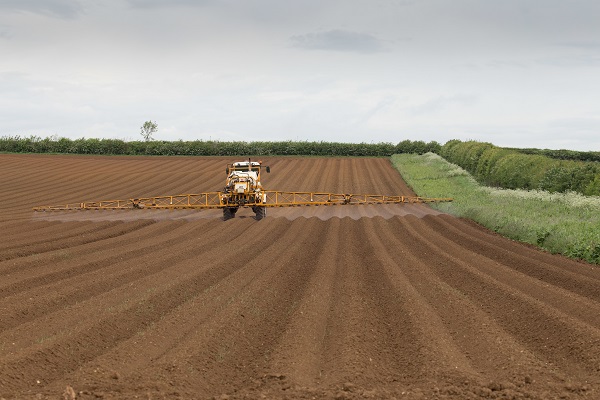What’s the best means of controlling weeds in potatoes following the loss of linuron? It’s a question many growers will be pondering but finding the answer may not be straightforward. CPM investigates.
Mixing partners are important to maximise performance on weeds.
By Lucy de la Pasture and Rob Jones.
When it comes to choosing which actives should make up a residual herbicide programme, the first consideration must be the weed spectrum likely to be found in each field, says Eric Anderson of Scottish Agronomy. But that’s not the end of the story, crop safety is also a primary concern and cost yet another consideration that may affect herbicide decisions, he adds.
After the withdrawal of linuron last June, few growers are likely to have stock but for those that do, the use-up period ends on 3 June 2018. Eric suggests growers consider which alternatives will best do the job for them.
“Some advisers have suggested that Praxim (metobromuron) could serve as a replacement for linuron, but this oversimplifies matters, overlooking the broad range of alternative products available,” he says.
“Rates need to be maintained as some weeds, namely black bindweed and cleavers, are shown as moderately resistant (on the label). Where cleavers are a problem, this means adding either pendimethalin or prosulfocarb to the mix.
“In most situations, it’s also worth mixing Praxim with metribuzin for lasting control, though be wary of variety sensitivity to metribuzin on all soil types, particularly with Cabaret, Lady Clare and Lady Balfour,” he says.
An alternative is to apply Artist (flufenacet+ metribuzin), he suggests, an option he now finds more attractive since Bayer has recently expanded its list of tank-mix partners.

Keeping water volume up is the best strategy for hitting small weeds on sloping ridges.
“Artist has always given excellent control of annual meadow grass (AMG) due to its flufenacet content, and the metribuzin element has ensured lasting control of a range of weeds, but the list of compatible tank-mix partners has previously been limited. Fortunately it’s not any longer,” comments Eric.
As part of the work to support more tank-mix partners, a series of trials were performed in 2017, with Scottish Agronomy serving as one of the trials contractors.
“At the Fife trial, Artist gave better pre-em control of AMG and fat hen than either straight metribuzin (applied as Shotput at the same rate of active ingredient contained in Artist). It also outperformed a three-way mix of Shotput plus Stomp Aqua (pendimethalin) plus Praxim,” he says.
Eric’s wider view is, while there’re a range of weed control options available to fill the space vacated by linuron, more work is needed to find which combinations perform best against a range of different weed species.
“This trial highlighted that, for certain weeds, mixing partners are important to maximise performance on weeds. For instance, where a mix of Artist plus Gamit (clomazone) was applied, it gave better control of black bindweed than Artist in a mix with either Praxim or Defy (prosulfocarb).”
Separate trials at Scottish Agronomy investigated a wider range of weeds. “With the exception of common field speedwell, which was controlled well by metribuzin, Artist gave better control of cranesbill, mayweed, groundsel, sow thistle and orache than either straight Defy or two applications of metribuzin,” he adds.
Agrovista agronomist Luke Hardy advises potato producers in Shrops, Staffs, South Derbys and North Warwicks, on a wide range of soil types and weed spectrums. He agrees with Eric that it’s important to be proactive in looking at herbicide alternatives rather than just waiting for change to be thrust upon the industry.
“Growing good quality potatoes, often on rented land with weed profiles that you’re not always 100% sure of, has always been a serious business. But my advice to growers and other advisers has always been to try new chemistry when its available,” he says, believing the knowledge gained will help them stay ahead of the game.
As well as the obvious gap left by linuron, Luke is investigating weed control options with a view to finding a replacement for regular tank-mix partner, diquat, which is another stalwart under the eye of the regulator.
“Following the recent loss of linuron, and with serious question marks over diquat, the logical step was to look for an alternative. So I tried Gozai (pyraflufen-ethyl) last season to get a proper feel for it before any more key actives leave the armoury. You simply can’t afford to sit back and wait for another withdrawal to force your hand.” he explains.
“I used to build many of my herbicide programmes around carfentrazone and diquat, particularly for tackling nettles and volunteer oilseed rape, but I was never entirely satisfied with the combination’s performance on mayweed,” he comments.
Initially Luke started using Gozai at 0.3 l/ha alongside diquat at 1.5 l/ha, but he also trialled it with some of his favoured residuals, such as Soleto (metobromuron) or prosulfocarb, depending on the soil types and variety. One of his key findings has been the importance of water volume in ensuring best herbicide performance.
“The key to maximising the effectiveness of Gozai is to keep water volumes up to make sure there’s good coverage. One customer did try it in a mix at a water volume of 150 l/ha, but I believe you really must look at 200 l/ha as a minimum to get sufficient herbicide coverage. You’re not spraying flat fields of wheat, you’re spraying ridges and often on sloping fields,” he points out.
After a year’s experience, Luke has found Gozai more effective on both mayweed and groundsel than carfentrazone. He describes resistant poppies as a particular problem in land around Lichfield, but he found the new herbicide seemed to deal with them well.
“It’s certainly a viable alternative to diquat, either as a tank-mix or as an add-in. The key is to invest in an effective early pre-em programme to avoid the need for a follow-up spray. I’m not a great fan of a post-em using Titus (rimsulfuron), as it often knocks the crop back by up to two weeks,” he adds.
Looking ahead to this season, he’s keen to assess how Gozai performs in different situations, particularly away from its usual positioning in his residual stack.
“After applying the residuals 14 days after planting, as I would normally, I intend to use Gozai on its own at the full rate of 0.4 l/ha and time the application at around 4-5 days before the crop emerges, just as the ridges are cracking. In situations when weeds are larger than four true leaves, then I will add methylated rapeseed oil to the contact herbicide to help tackle the larger weeds,” he says.
New herbicide is in development
Based on the active substance aclonifen, Bayer is preparing to bring a new herbicide product to the UK market, approval permitting. An application has been submitted to the Chemicals Regulation Division (CRD) for a maximum application rate of 3 l/ha of the pre-em herbicide, code named SP01644.
“Aclonifen is a diphenyl-ether, a bleaching compound that’s taken up by the hypocotyls, cotyledons and coleoptiles of weeds. It’s then translocated to the meristems causing bleaching and chlorosis of young shoot tissue as it develops,” explains Edward Hagues, Bayer campaign manager for roots.
It isn’t a new active, Aclonifen has been in use across Europe for more than 15 years, says Edward. “It has a broad spectrum of activity – with good control of small nettle, brassica weeds, Chenopodium weeds (such as fat hen and orache) and a range of polygonum species, with a useful contribution to the control of mayweed and grassweeds (from seed).”
Eric adds that it looks to be a useful partner for Artist. “It brings increased control of black bindweed.”
Bayer’s aware of the desperate need for alternatives to linuron in many vegetable crops, particularly the umbelliferous crops (carrot, parsnip, celery, celeriac and many herbs), but also in onions and vegetable peas and beans.
To address this, it’s working closely with AHDB, crop groups and CRD to gain label extensions or EAMUs for use in these crops, in line with the approval in potatoes.
Bayer has several herbicide trials involving SP01644 this season and welcomes growers keen to see its performance ahead of its possible introduction in 2019, adds Edward.
Faster emergence helps weed control
A potato crop that’s quickly through the ground and able to compete with weed seedlings is a great help to any pre-em herbicide programme. That means control of pests and diseases that may slow down emergence or crop growth can have a knock-on effect on weed control strategies, according to the results of new trials presented at this winter’s Syngenta Potato Science Live events.
They’ve shown control of potato cyst nematode (PCN) using Nemathorin (fosthiazate) enabled faster and more consistent crop canopy development, with benefits for weed suppression and greater photosynthetic activity delivering higher yields.
Research by SRUC in Arbroath, showed an average of 31% greater ground cover was achieved by 64 days after planting where crops were treated with Nemathorin. The trials were carried out using varieties Harmony and Maris Piper, in a field with a known PCN population of Globodera pallida at 34 eggs/g of soil.
“Harmony is known for its partial resistance to both G. pallida and G.rostochiensis, but it still responded very positively to the Nemathorin treatments, with plots showing up to 40% greater ground cover compared with the untreated plots,” reports Syngenta’s David Wilson.
“The Maris Piper, which is known to be particularly susceptible to G. pallida, was even more responsive to the effective PCN control,” he adds.
The white PCN, G. pallida, is the most challenging of the soil pests, with an AHDB survey revealing that 48% of tested land was infected with PCN populations – and of those 95% contained G. pallida, with just 5% purely G. rostochiensis.
“G. Pallida cysts have a longer hatching period over the growing season, compared with G. rostochiensis, which makes the extended control offered by Nemathorin especially important because it’s better able to protect roots from damage, enabling healthy plants to develop.”
David points out that fast ground cover helps the crop to shade out weed seedlings and get the best possible results from residual herbicide applications. “The greater cumulative light interception by the bigger canopy sets the foundation for higher yields,” he adds.
The SRUC trials showed that Nemathorin treatment produced an average 24t/ha yield increase in the Maris Piper over untreated, and over 16t/ha compared with the development SDHI treatment for PCN containing fluopyram. In the Harmony crop, the yield increase was more than 20t/ha over the untreated plots and 14.5t/ha compared with those treated with fluopyram.
“For growers and agronomists looking to optimise an Integrated Crop Management Programme, getting the crop emerged and growing rapidly is the key first step,” he advocates. “These trials have demonstrated that where PCN is recognised as an issue, Nemathorin has an essential role in assuring a sustainable potato operation.”




